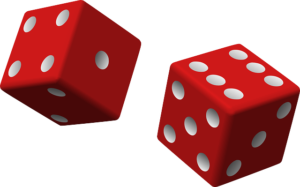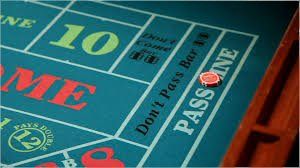How to Take Craps Odds and why you should.
 Explaining craps odds isn’t one of the easiest things to do. I’ve seen a hundred pages try to do it, and most aren’t very successful. It’s not because they are incorrect, but there are usually one of two problems (if not both). First of all, they all seem to assume the reader knows everything else there is to know about craps already. Second, they don’t explain the math very well.
Explaining craps odds isn’t one of the easiest things to do. I’ve seen a hundred pages try to do it, and most aren’t very successful. It’s not because they are incorrect, but there are usually one of two problems (if not both). First of all, they all seem to assume the reader knows everything else there is to know about craps already. Second, they don’t explain the math very well.
I can say this, because I’ve been that reader before. I’ve been the person trying desperately to learn how to play craps; the one that was too intimidated to approach the table or ask for help. I did a great deal of reading on the subject, and the one thing that took me the longest to grasp was the concept of Taking Odds and Laying Odds in craps.
So, today I will try to explain it in a way that makes as much sense as possible. I’m not going to teach you to play the entire game—that would be too much info all at once. But I will start with the most basic of bets in which odds can be taken on, and go from there.
How to Take Craps Odds – 3x, 4x and 5x
 Every new game of craps starts with a Come Out roll. This is the shooter’s first roll, meant to establish a Point. At this time, you should place a wager on the Pass Line. It pays even money, and has a house edge of 1.41%. Here’s what happens next, based on the shooter’s roll:
Every new game of craps starts with a Come Out roll. This is the shooter’s first roll, meant to establish a Point. At this time, you should place a wager on the Pass Line. It pays even money, and has a house edge of 1.41%. Here’s what happens next, based on the shooter’s roll:
– Shooter rolls a 7 or 11: Player wins
– Shooter rolls 2, 3 or 12: Player loses
– Shooter rolls 4, 5, 6, 8, 9, or 10: A Point is established. The number rolled becomes the Point.
– Once a Point is established, your Pass Line wager becomes a new bet that the Point will roll again before a 7. Now you have the option Take Odds.
Taking Odds in Craps
The amount you bet to take odds will depend on the Point. This is where the 3x, 4x and 5x labels come in.
Point is 6 or 8: Bet 5x Odds
Point is 5 or 9: Bet 4x Odds
Point is 4 or 10: Bet 3x Odds
That multiplier tells you what multiple of your original Pass Line wager to bet. If you wagered $5 on the Pass Line, and the Point is 6, you would bet 5x that amount (5 x $5 = $25) to take odds. The bet is placed on the table behind your Pass Line bet (between the Pass Line and wall).
The reason the amount varies is because the odds of each Point rolling again before a 7 varies. For example, a 6 (or 8) has a 13.89% chance of rolling. A 7 has a 16.67% chance of rolling. All other possible numbers have a combined 69.44% chance of rolling. We can eliminate all those other numbers, because they don’t matter. Nothing happens if we roll them. Which leaves us with…
5 ways to roll a 6, and 6 ways to roll a 7. Breaking that down, we get…
Odds of 6 rolling is 5 out of 11 (45.55%)
Odds of 7 rolling 6 out of 11 (54.55%)
Thus, by paying 6-to-5, the player is getting what’s known as “Fair Odds”; meaning there is no house edge on the bet. The same goes for the 4x and 3x bets, where the odds of winning match the payoff for taking odds on 5 or 9, and 4 or 10.
So, to answer the question, why you should always take odds, it’s because this is the only time you’ll ever get fair odds in a casino. Every other game—every other wager—comes with a house edge. Take the odds! Or, lay them…
Laying Odds in Craps
Now that you know how to take craps odds, you need to know how to lay craps odds as well. Laying odds is the exact opposite of taking odds.
Above, we covered the traditional, opening Pass Line bet. Some players chose the dark side, betting against the shooter with a Don’t Pass Bet.
In contrast to a Pass Line bet, the Don’t Pass bet has the following effects:
– Shooter rolls a 7 or 11: Player loses
– Shooter rolls 2, 3 or 12: Player wins
– Shooter rolls 4, 5, 6, 8, 9, or 10: A Point is established. The number rolled becomes the Point.
– Once a Point is established, your Don’t Pass wager becomes a bet that a 7 will roll before the Point comes again. Now you have the option Lay Odds.
It works the same as taking odds in craps, except this time you’re betting against the point, in hopes that a 7 will roll first. To keep it fair, the odds are reversed. 7 against a point of 6 or 8 pays 5 to 6, 5 or 9 pays 2 to 3, and 4 or 10 pays 1 to 2.









